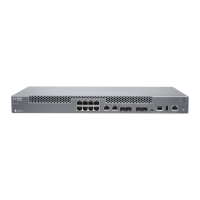To disconnect a fiber-optic cable from an optical transceiver installed in the MX150:
1. (Recommended) Disable the port in which the transceiver is installed by including
the disable statement at the [edit interfaces] hierarchy level for the specific interface.
WARNING: Do not look directly into a fiber-optic transceiver or into the
ends of fiber-optic cables. Fiber-optic transceivers and fiber-optic cables
connected to transceivers emit laser light that can damage your eyes.
WARNING: Do not stare into the laser beam or view it directly with optical
instruments even if the interface has been disabled.
2. Carefully unplug the fiber-optic cable connector from the transceiver.
3. Cover the transceiver with a rubber safety cap.
WARNING: Do not leave a fiber-optic transceiver uncovered except when
inserting or removing a cable. The rubber safety cap keeps the port clean
and prevents accidental exposure to laser light.
4. Cover the fiber-optic cable connector with the rubber safety cap.
Related
Documentation
Installing a Transceiver in an MX150 on page 103•
• Connecting a Fiber-Optic Cable to an MX150 on page 105
Maintaining Fiber-Optic Cables in an MX150
To maintain fiber-optic cables in MX150:
•
When you unplug a fiber-optic cable from a transceiver, place rubber safety caps over
the transceiver and on the end of the cable.
•
Anchor fiber-optic cable to avoid stress on the connectors. When attaching a fiber-optic
cable to a transceiver, be sure to secure the fiber-optic cable so that it is not supporting
its own weight as it hangs to the floor. Never let a fiber-optic cable hang free from the
connector.
•
Do not bend fiber-optic cables beyond their minimum bend radius. Bending the cables
beyond their minimum bend radius can damage the cables and cause problems that
are difficult to diagnose.
•
Frequent pluggingand unplugging of fiber-optic cables in and out of optical instruments
can damage the instruments, which are expensive to repair. Attach a short fiber
107Copyright © 2017, Juniper Networks, Inc.
Chapter 16: Maintaining and Replacing Fiber-Optic Cable

